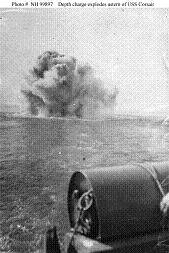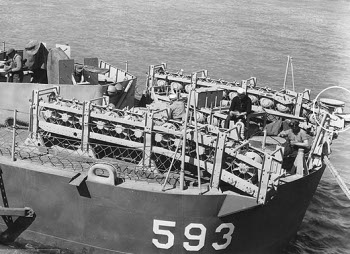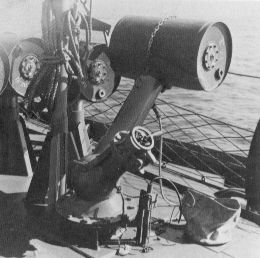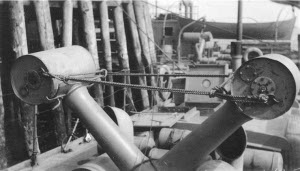![]() The Pacific War Online Encyclopedia
The Pacific War Online Encyclopedia
|
| Previous: Denfeld, Louis Emil | Table of Contents | Next: Derby |

Naval
Historical Center #NH 99897
The depth charge was the basic antisubmarine weapon of the Second World War. It was a large (200 lb/90 kg or more) explosive charge with a fuse that could be set to explode the charge at the estimated depth of the submarine. At very close range, the resulting shock wave was capable of buckling a submarine pressure hull, resulting in catastrophic failure and the destruction of the submarine. Such close detonations proved difficult to achieve, and the submarine usually had to be battered to death with dozens of depth charges.
The U.S. Navy had no clear idea what the lethality of depth charges was prior to 1940, when
Commander Francis S. "Frog" Low proposed taking a newly completed
submarine to sea and dropping depth charges on it to evaluate its
resistance to damage. With war looming, this radical proposal was
surprisingly well received, and Tambor was ordered to
make itself available for such tests. A 300 lb. (136 kg) charge rigged
for controlled detonation was moored under a buoy, and the submarine was
ordered to maneuver to within various distances of it, starting at 500
yards (460 meters). There was concern for the safety of the crew even at
this distance, but American submarines proved sterner than expected,
and no damage at all was recorded until the charge was detonated at a
distance of 275 yards (250 meters) from the boat. The final tests,
ranging from 100 yards (90 meters) to 100' (30 meters), were conducted
with no crew aboard and the submarine moored in place. At the minimum
distance of 100', the hull remained undamaged, but internal damage was
great enough that the tests were terminated. Based on the test results,
the Navy extensively redesigned various items of equipment and fittings,
particularly electrical cables passing through the pressure hull.
By the end of the war it was assumed that a 300 lb (136
kg) depth charge had to be less than 14 feet (4 meters) from a
submarine to buckle its hull, 30 feet (9 meters) to disable it, and 60
feet (20 meters) to do significant damage. The kill radius increased
with increasing depth, since the hull of a deeply submerged submarine
already had considerable hydrostatic loading on it. When a submarine
was already near its crush depth, it didn't take much of an additional
shock to induce catastrophic failure.
Being subjected to an accurate depth charge attack was a terrifying
experience. Until quite late in the war, there was no way for a
submarine to effectively counterattack an antisubmarine vessel dropping
depth charges on its position, and the submarine could only take
evasive maneuvers and hope for the best. The nearby detonation of a
depth charge produced a sharp metallic bang from the shock wave hitting
the submarine hull, followed by a much louder boom from the sound waves
from the explosion. The closer the depth charge, the closer together
the bang and the boom were. If they were nearly simultaneous, they might be the last sounds the crew ever heard.
An experienced submarine commander could use the interval between the bang and boom to estimate how far away the depth charge was, which aided evasion. Certain sonar sets were also capable of determining the distance to the charge, as well as its approximate direction, though the latter were not available until 1944. The initial shock wave was responsible for most of the damage from a depth charge, but the bubble of hot gas produced by a depth charge explosion underwent violent oscillations that produced secondary pressure pulses. Though these were much weaker than the initial shock wave, they were also much longer in duration, and may have contributed significantly to the destructiveness of the depth charge near the limits of its lethal radius.
The heavy depth charge armament of a destroyer carried risks
to its own crew. Although depth charges were equipped with safe
mechanisms to prevent accidental detonation, and instructions were
issued to the U.S. Fleet to leave depth charges on safe until just
before they were used, there were repeated instances during the war of
the depth charges of a sinking destroyer detonating and killing sailors
who had abandoned ship. The preponderance of evidence suggests that the
safe mechanisms were unreliable, rather than that their users were careless about the safe settings.
Japanese depth charges were rather light, and in the early days of the war they were usually fused too shallow, allowing many American submarines to escape. The Japanese were apparently unaware that the more modern American subs could dive to 300 feet (90m) or more. Japanese escort commanders also had a tendency to assume a kill at the first sign of floating oil or debris. However, one of the stupidest men to ever darken the doors of the United States Congress revealed in a press conference that U.S. submarines were capable of diving deeper than the Japanese thought, and thereafter Japanese kills of U.S. submarines increased. The Congressman in question was politically powerful and was able to avoid any immediate consequences, but was convicted on an unrelated charge of accepting bribes after the war ended.
All Japanese depth charges had dimensions of 30.5"
by 17.7" (77.5cm by 45cm). The
Type 95 was standard at the time war broke out, with a 220 lb (100 kg)
charge of Type 88 explosive (ammonium perchlorate and ferrosilicate).
Its fuse had a water inlet that detonated the charge when a
certain amount of water had entered. There were just two depth
settings, 100 feet (30m) and 200 feet (60m), the latter well above the
dive depth of American subs. Later the charge was increased to 324 lb
(147kg) of Type 97 explosive (70% TNA/30% HNDA) and a 300 foot (90m)
setting was introduced. Slow ships could
drop the charge with a parachute to retard its sinking until the ship
was clear, but this reduced the depth setting to a maximum of 100 feet
(30m). The Type 2, introduced later in the war, was similar to British depth charges, with
230 lbs (105kg) of Type 97 explosive and depth settings of 98 feet, 197 feet, 292
feet, 390 feet, and 480
feet
(30m, 60m, 89m, 120m, and 145m). Later versions of the Type 2 had up to 357 lbs (162kg) of
explosives. The Japanese experimented with a depth charge having 220
lbs (100 kg) of explosives and a magnetic influence fuse, but this
weapon did not reached production before the surrender.
The Japanese loaded depth charges on almost every ship that could carry
them, and they made heavy use of depth charge throwers, even on
merchant ships. The typical loadout on a fleet destroyer was about 30 depth charges, while dedicated escort ships had a very large loadout, of as many as 300 depth charges.
The Japanese also developed air-deliverable depth bombs. The Navy Type 99 Model 6 Mark 2 was a 132 lb (60 kg) weapon with a kill radius of about 12 feet (4 m). It was the usual weapon carried by aircraft on routine patrol. The Type 1 Model 25 Mark 2 was 551 lb (250 kg) weapon with a kill radius of about 33 feet (10 m) that was normally loaded only when a target was already located by surface ships or another aircraft. There was also a experimental Type 19 Model 25 Mark 2 of 398 lbs (180 kg) weight and with a kill radius of 25 feet (8 m), which was intended for the Q1W "Lorna" and other aircraft with magnetic anomaly detectors. All of these depth bombs used timed fuses corresponding to various estimated depth settings. The Type 15 fuse could set for any depth up to 50 feet (15m), though the selection had to be made when the bomb was loaded on the aircraft. Other fuses were preset for 80, 150, or 300 feet (26, 46, or 91m). The last corresponded to a time delay of 17 seconds.
The Americans began the war with two types of depth charges. The
Mark 6 depth charge had a 300 lb (136 kg) charge of TNT and could be
set to explode at 30 to 300 feet (9 to 90 meters). The sinking rate was
8 feet per second (2.4 m/s). The U.S. Navy conducted tests with the
Mark 6 and optimistically concluded that it would inflict fatal damage within 30 feet (10
meters), serious damage within 60 feet (20 meters), and significant
damage within 90 feet (30 m). The Mark 7 depth charge was similar to
the Mark 6 but had
a 600 lb (270kg) charge. Later models
of both types could be fused to 600 feet (183m) to reach the deep-diving German U-boats, and had additional
ballast to increase the sinking rate to 12 feet per second (3/7 m/s).
The Mark 9 had a teardrop shape and fins to make it spin and thus
stabilize its underwater trajectory, but this came at the cost of
reducing the charge to 200 lbs (90 kg) of Torpex, in order to allow the
weapon to fit in existing Mark 6 tracks and throwers. Sinking rate was
14.5
feet per second (4.4 m/s). Some of the later versions could be set as
deep as 1000 feet (300m).
The Mark 8 entered service in early 1943 and had a magnetic influence fuse that proved as unreliable as that of American torpedoes. It had a backup hydrostatic fuse that could be set as deep as 500 feet (152 meters). The Americans also experimented with an acoustic fuse, which proved much more effective than the magnetic influence fuse, but this was not ready before the surrender.
AN Mk41 depth bomb. U.S. Navy via navsource.org.
Click to enlarge
The chief American air-deliverable depth charge when war broke out was the AN Mk 17, a 325 lb (147 kg) weapon with a charge of 234 lb (106 kg) of TNT. This had impact and hydrostatic fuses, the latter rather unreliable. It tended to ricochet until a nose plate was added. A flat nose version was eventually introduced as the Mk 41.
U.S. tactics at the beginning of the war were to drop a pattern of
seven depth charges over the likely location of a submarine. An
American destroyer of this period typically carried enough depth
charges for four such patterns. This proved inadequate, and some Bensons
were modified to carry enough depth charges for seven or more patterns.
Postwar analysis showed that a depth charge attack in the Battle of the Atlantic had about a 6% chance of sinking the target. The figure was likely higher against Japanese submarines in the Pacific, since Japanese submarines could neither dive as deeply or as quickly as the German U-boats. It was likely lower against U.S. submarines, given the depth limitations of early Japanese depth charges. Less than 22 U.S. submarines were lost to depth charge attack in the Pacific, while the Japanese lost as many as 85 submarines to depth charge attack.
The British entered the Pacific War with the Mark 7 Heavy depth
charge, which was based on the earlier Mark 7 but with a heavy cast iron
ballast attached. This depth charge weighed 570 lbs (259 kg) and
carried 290 lbs (132 kg) of Amatol capable of disabling a submarine at
40' (12m) distance. Sink rate was 16.8 feet per second (5.1 m/s). The
fuse could be set for depths up to 1000' (305m). In December 1942, the
charge was switched to more powerful minol, which increased the
effective radius to 52' (15.8 m).
The Mark 10 was introduced in March 1942 and was designed to be fired
from torpedo tubes. It was an extremely heavy depth charge, weighing
3050 lbs (1383) of which 2000 lbs (907 kg) was minol. It was originally
equipped with buoyancy tanks to reduce the sinking rate to 6 feet per
second (1.8 m/s) to give the launching ship time to get clear (assuming a
fuse setting of 220' or 67 meters), but it was found that a less
buoyant version with a sink rate of 21 feet per second (6.4 m/s), the
Mark 10 *, could be safely set for 640' (195m) by a ship making 11
knots. These depth charges were designed with deep diving German U-boats
in mind, and very likely saw no service in the Far East.

The oldest method for delivering depth charges was simply to roll
them off the stern of a ship as it passed over the estimated location
of the submarine.Destroyers were equipped with one or two depth charge
racks equipped to drop the charges one at a time on command.

NavWeaps.com. Fair use may apply.
A weakness of depth charge attacks from stern racks was that sonars of the period were unable to track a submarine directly under the escort vessel. This gave the submarine a chance to evade at the last moment. The Allies developed cooperative tactics in which a second escort guided the attacking escort over the target, and they also made use of depth charge throwers that could throw a depth charge some distance to the side of the attacking ship. The Japanese were particularly fond of depth charge throwers, mounting as many as eight on their dedicated antisubmarine escort vessels.
The U.S. Mark 6 depth charge projector, also known as the K gun, was
typical. It was essentially a fixed black powder mortar
whose range was
adjusted by using different black powder charges. These gave ranges of
50, 75, and 120 yards (45, 70, 110 meters) with a Mark 6 depth charge
or 60, 90, or 150 yards (55, 80, or 140 m) with a Mark 9 depth charge.

Naval History and Heritage Command #NH 41995
The K gun was introduced in 1936 but was not produced in quantity until June 1941, and older destroyers had to make do with the Y gun, which sat on the centerline of the ship and simultaneously discharged mortars to either side. It was an awkward weapon, weighing four times as much as the K gun, and it was disliked by its crews, being much more difficult to reload than the K gun.
The Japanese counterpart of the K gun was the Type 81 depth charge thrower. It could throw a Type 95 depth charge up to 93 yards (85 meters).
As the war progressed, new antisubmarine weapons such as the Hedgehog and the "Fido" homing torpedo
were developed, but these never entirely replaced the depth charge.
In fact, by late 1944, the British were in the process of
replacing Hedgehog with Squid on new construction, which represented a
return to the depth
charge thrower. Squid consisted of a pair of three-barrel mortars whose
pattern of six depth charges was normally fired dead ahead, but could be
trained 30 degrees to the sides if warranted. Each charge weighed 390
lbs (177 kg) of which 207 lbs (94 kg) was minol. These had a sinking
rate of 43.5 feet per second (13.3 m/s) and the fuses operated by
clockwork. The pattern was overlapping triangles 40 yards (37m) on a
side with the depth of the triangles set 60' (18m) apart. Squid was
equipped with a fire control system that
was tied directly into Type 147 sonar
and automatically set the detonation depth
and fired the charges from the mortars at the right moment. It was
estimated that Squid was nine times as effective as a conventional depth
charge attack, or over twice as effective as Hedgehog, with about a 40.3% probability.
However, the great weight of Squid meant that it could be retrofitted
to existing designs only by removing a substantial fraction of the
antiaircraft armament, and this was done rather haphazardly on older
destroyers being converted to escorts and other ships undergoing long
repairs.
References
Campbell
(1985)
Friedman
(1995, 2006)
Keegan
(1988)
Lacroix
and Wells
(1997)
ORD-ONI 9 (1944-12-1; accessed 2013-1-19)
Sternhell and Thorndike (1946; accessed 2013-1-19)
War Damage Report #58 (1949-1-1; accessed 2011-12-18)
The Pacific War Online Encyclopedia © 2006, 2008-2009, 2011-2014 by Kent G. Budge. Index